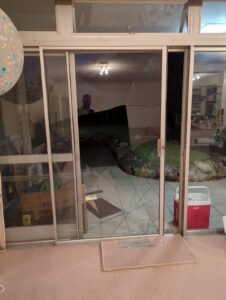
What is Safety Glass
Safety glass is engineered to be substantially more robust than conventional glass, demonstrating a heightened resistance to breakage. It finds its applications broadly, from automobile windshields to doors and windows, or any location that holds a risk of human impact.
Different Types of Safety Glass
Toughened Glass
Toughened glass is created by heating regular glass to high temperatures and then cooling it abruptly. This treatment results in a product that is approximately five times sturdier than ordinary glass. On the rare occasions when it does break, it crumbles into tiny, dull-edged pieces instead of sharp, dangerous shards.
Laminated Glass
Composed of two or more glass sheets bonded together with a plastic interlayer, laminated glass exhibits an additional safety feature. If broken, the plastic interlayer retains the fragments, significantly reducing the risk of injury.
Wired Glass
A less commonly used variety of safety glass, wired glass involves embedding a metal mesh during the manufacturing process. It’s considered a grade B safety glass and is seldom chosen for contemporary applications.
Compulsory Use of Safety Glass in Australia
Wherever there is a risk of human impact, the use of safety glass is mandated. The fundamental reason for this rule is the decreased likelihood of breakage and injury compared to regular glass.
Choosing the Right Safety Glass
| Image | Description |
|---|---|
 |
Automobile Windshields
|
 |
Residential Windows
|
 |
Australian Glass Balustrades
|
 |
Areas Near Swimming Pools
|
 |
Doors
|
 |
Side Panels Near Doors
|
 |
Glass Mistaken for Doorways/Openings
|
 |
Bathrooms
|
 |
Low-Level Windows
|
 |
Two Edge Unframed Glazing (Sashless Windows)
|
 |
Stairway Glazing
|
While laminated safety glass offers superior protection against breakage and injury, it also carries the highest cost among the different types. Therefore, if budget constraints exist, toughened safety glass presents a cost-effective alternative that still provides robust protection.
What Are Safety Glass Requirements in Australia?
As a general guide, you will need safety glass in the following areas according to AS1288 Standards –
- all glass doors
- door side panels (if less than 0.3m away from the door and positioned 1.2m or less above the floor)
- bathrooms (for all areas up to 2 metres high)
- areas that can be mistaken for openings
- around stairs (for a distance of 1m from either side of the stairs and 2m from the bottom of the stairs)
- low level glass (if larger than 1.2 metres – areas under 1.2 metres require a minimum of 5mm thick glass)
Case Study - Home Safety Upgrade with Toughened Glass in Ashfield
Sarah Qin faced a scary situation when her accidentally rode he’s tricycle into the glass door and shattering it on impact in their 1980s-built home. A large piece of glass narrowly missed her son, shocking the entire family.
Swiftly seeking professional advice, Sarah enlisted the help of Khalil from Splendid Window Glass Repairs. Khalil inspected the property and confirmed that the existing glass, being standard float glass from the 1980s, did not meet the current AS1288 safety standards.
Despite the substantial expense, Sarah decided to replace all the glass in her home with toughened safety glass. This significant decision has since brought the family peace of mind, as the new glass is highly durable and has eliminated fears of potential glass-related accidents. This case highlights the crucial importance of safety glass in homes, especially those with young children.


Khalil is the owner of Splendid Window Glass Repairs and has over 8 years experience as a glazier specialising in window glass repair, replacement and installations. Khalil takes great pride in his work and prides himself on providing an excellent service to all of his customers, no matter how big or small the job may be.
